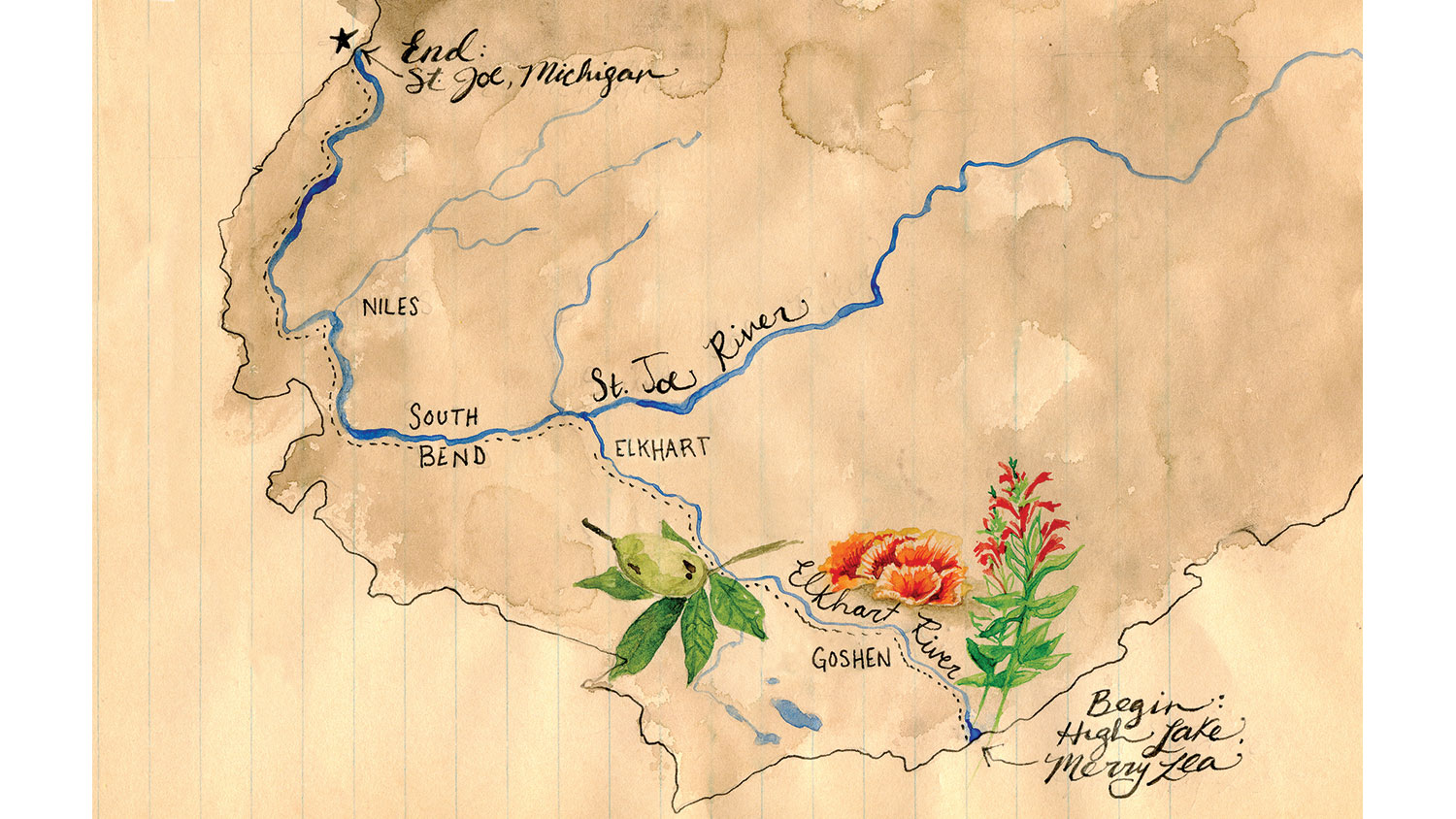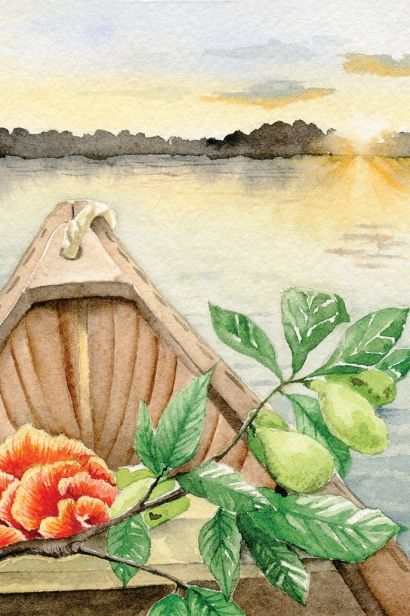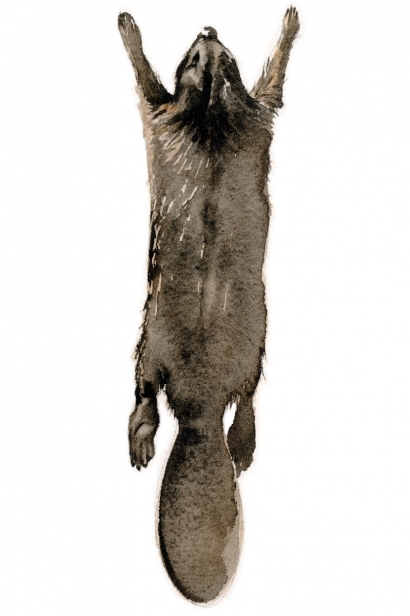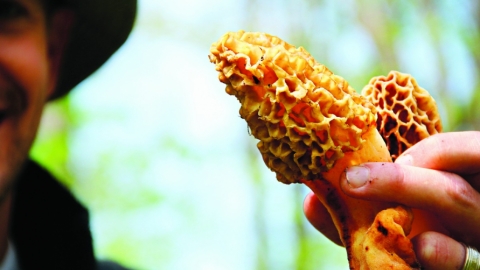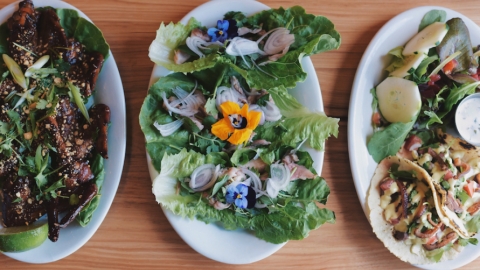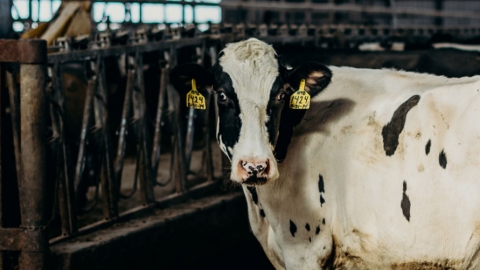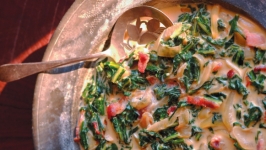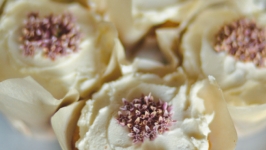Merry Lea students forage on canoe trip along Elkhart River
Every year in September, I lead students from Goshen College’s Sustainability Leadership Semester on an eight-day canoe trip from the headwaters of the Elkhart River at Merry Lea Environmental Learning Center to Lake Michigan. Along the river we forage wild food and meet with local entrepreneurs, pastors, artists, community developers, restaurateurs, professors, NGO professionals, residents, farmers and political leaders. In these interactions we explore many ways to contribute to resilience in our places and sustainable futures for our communities. Michiana’s local foods community is a main thread in our conversations.
Chicken of the Woods
Our paddles churn the surface of the Elkhart River as our canoes glide around a sweeping bend. The world is glowing green beneath the shade of the broad-leafed sycamore canopy on this crisp afternoon. Cardinal flowers bow to the river, red from the dark, exposed soil. A great blue heron spooks downstream as a train rumbles by on the riverside rail. Soon we see fluorescent orange and yellow in the crook of a two-trunked wild cherry tree. As we float closer, we confirm that what we’re seeing is an edible mushroom called chicken of the woods.
José Chiquito and I maneuver our canoe to the mucky shoreline. Chiquito is a sustainability studies major who is active in the local foods community. We laugh as we struggle out of our unstable boat. Once on solid ground, we examine the mushroom colonies, noting their condition and age. Chiquito slices a few selections from the trunk with a pocketknife, and we continue downstream.
Later that evening, the campfire crackles as students hover around a cast-iron frying pan with forks in hand, tasting thoughtfully.
“Oh, wow, this chicken of the woods really does have the consistency of chicken,” comments Reena Ramos. She gestures positively with raised eyebrows and takes another bite.
We talk about others who may have eaten this food in this place. This place is home to the Potawatomi people who have eaten this mushroom seasonally for generations. We delight in the reality that we are among many—people, chickadees, coyotes, elk and ants—that have shared this food before.
Paw Paw
Downstream of Goshen, the river widens, growing larger with each tributary. Groves of paw paw trees, with sweeping oval leaves, grow densely along the banks. The yellow-green fruits hanging from these trees look tropical, and are known to some as the “Indiana banana.” Paw paws are plentiful here along the river’s edge, but ripe fruits can be scarce elsewhere as squirrels and raccoons gobble them up.
I quarter the succulent mango-like fruits, and we chew down to the flat, nickel-size seeds. Student Laura Hochstetler makes plans to use paw paw fruits in baked goods at the bed and breakfast she hopes to create, where visitors will learn how to grow and preserve food, how to operate renewable energy systems and other living skills.
We return to the shore many times for more fruit.
Lake Michigan
After eight full days on the river, we feel as if the water is moving into the last bit of its course to Lake Michigan.
We enter a rusty-walled canal, and the water surges in every direction. Energy builds as we slosh about and try to hold our line. Beyond the St. Joseph North Pier Lighthouse, we cut sharply toward the shore, safely beyond the traffic of barges and yachts. Canoe hulls slide onto sand, and we all run and dive into the exhilarating cold, teal body of water.
Our final portage takes us over the top of the sand dune at Tiscornia Park, where we reluctantly (and excitedly) load the boats aboard our blue canoe trailer. We have one final stop before heading back to the top of the watershed.
Silver Beach Pizza.
We enjoy the Parugula with oiled crust, prosciutto, arugula and Parmesan and the Harvest with brown-sugared and oiled crust, kale, bacon, Gouda and butternut squash.
Headwaters Feast
I receive a call from a friend who works for the county ditch and drain commission removing beavers from agricultural ditches to keep water levels down for row crop farmers.
“Hey, I have a beaver if you still want him.”
“Yes! Can you make it to the feast?”
“I’ve been trapping for 30 years and I’ve always wanted to try the tail. Read about it in Lewis and Clark’s journals. I’ll be there.”
If it were up to me, the beavers would stay alive and well, creating rich wetlands as they do. However, since the trapped animals are usually left for coyotes, I feel OK about gleaning this food as a learning experience.
We return to Merry Lea Environmental Learning Center, where the students live in community for the rest of the semester at Rieth Village, residential cottages that model environmentally conscious design.
We process the beaver together, first removing his beautiful skin. For some of the students, it is the first time they have processed an animal they would later eat. Beneath the skin is scarlet muscle. We remove the tenderloins along the inside and outside of the spine, the front and back legs and the tail.
The next evening, the group transforms the meat into tikka masala; salsa verde sauté; traditional roast with carrots, onions and potatoes; charcoal-grilled tail; and teriyaki tenderloin.
This meaningful, delicious meal inspires lively conversation around the table. We wonder what other sources of sustenance and significance might surround us in everyday places we have yet to discover. As we eat, we recount the gifts that this journey has given and savor Michiana’s original flavors.


